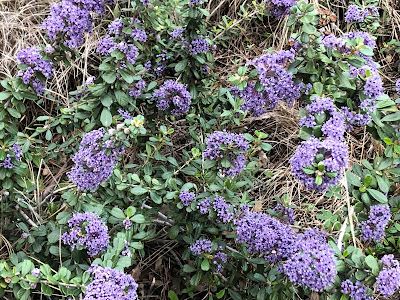
Take virtual visits to native plant gardens April 17-24
California native plants have been here all along, boosting native wildlife and helping keep our climate healthy. We can return the favor by planting and enjoying natives in our gardens and protecting them in our parks and wildlands.
Starting Saturday, the state celebrates California Native Plants Week, and native plants get a special boost from, not surprisingly, the California Native Plant Society. Their one-minute kickoff video can be viewed here .
CNPS is promoting the week with the theme "Grow CARE Everywhere." The acronym stands for a four-branch approach to enjoying and preserving California natives:
-- Cultivate. Nursery partners and local CNPS chapters are offering special events, plant sales and discounts .
-- Act. Dudleya plants are among natives in danger -- in this case, from poaching by people who want to cash in on the succulent trend. CNPS notes that plant poaching is a serious problem that puts dozens of species at risk every year. The group is supporting Assembly Bill 223 to make Dudley poaching illegal. Read more here and while you're there check out the adorable Dudleya GIFs associated with the various chapters of CNPS.
-- Restore. Local chapters work to promote and protect native plants in their areas. CNPS has 35 local chapters across the state; information on the Sacramento Valley Chapter is here .
-- Enjoy. This is the one we can do from anywhere that has Wifi: Take a new 360-degree virtual tour of native gardens every day of the celebration week. Get inspired by visiting real-world urban and mountain gardens, botanic gardens, parks and wildlands all over the state. See CNPS' special page for the week for all the links and details.

|
|
This beautiful specimen of ceanothus grows in the UC Davis
Arboretum and Public Garden, which has many natives.
|
Natives already know how to cope with the California climate -- including our drought years. And you'll be helping insects and birds, too, which depend heavily on native plants.
The nurseries in the area are increasingly tuned into the benefits of native plants, so don't be afraid to ask about the ones they carry. The UC Davis Arboretum sales are a great source for natives, too. Finally, check out this list at Calscape for ideas of native plants to grow.
Comments
0 comments have been posted.Sacramento Digs Gardening to your inbox.
Food in My Back Yard Series
April 1: Don't be fooled by these garden myths
March 25: Fertilizer tips: How to 'feed' your vegetables for healthy growth
March 18: Time to give vegetable seedlings some more space
March 11: Ways to win the fight against weeds
March 4: Potatoes from the garden
Feb. 25: Plant a fruit tree now -- for later
Feb. 18: How to squeeze more food into less space
Feb. 11: When to plant? Consider staggering your transplants
Feb. 4: Starting in seed starting
Sites We Like
Garden Checklist for week of March 30
Your garden doesn’t mind April showers. Get busy now to enjoy those future flowers.
* Get ready to swing into action in the vegetable garden. As nights warm up over 50 degrees, start setting out tomato, pepper and eggplant transplants.
* From seed, plant beans, beets, cantaloupes, carrots, corn, cucumbers, melons, pumpkins, radishes and squash. (Soak beet seeds overnight in water for better germination,)
* Plant onion sets.
* In the flower garden, plant seeds for asters, cosmos, celosia, marigolds, salvia, sunflowers and zinnias.
* Transplant petunias, zinnias, geraniums and other summer bloomers.
* Plant perennials and dahlia tubers for summer bloom.
* Transplant lettuce and cabbage seedlings.
* April is the last chance to plant citrus trees such as dwarf orange, lemon and kumquat. These trees also look good in landscaping and provide fresh fruit in winter.
* Smell orange blossoms? Feed citrus trees with a low dose of balanced fertilizer (such as 10-10-10) during bloom to help set fruit. Keep an eye out for ants.
* Apply slow-release fertilizer to the lawn.